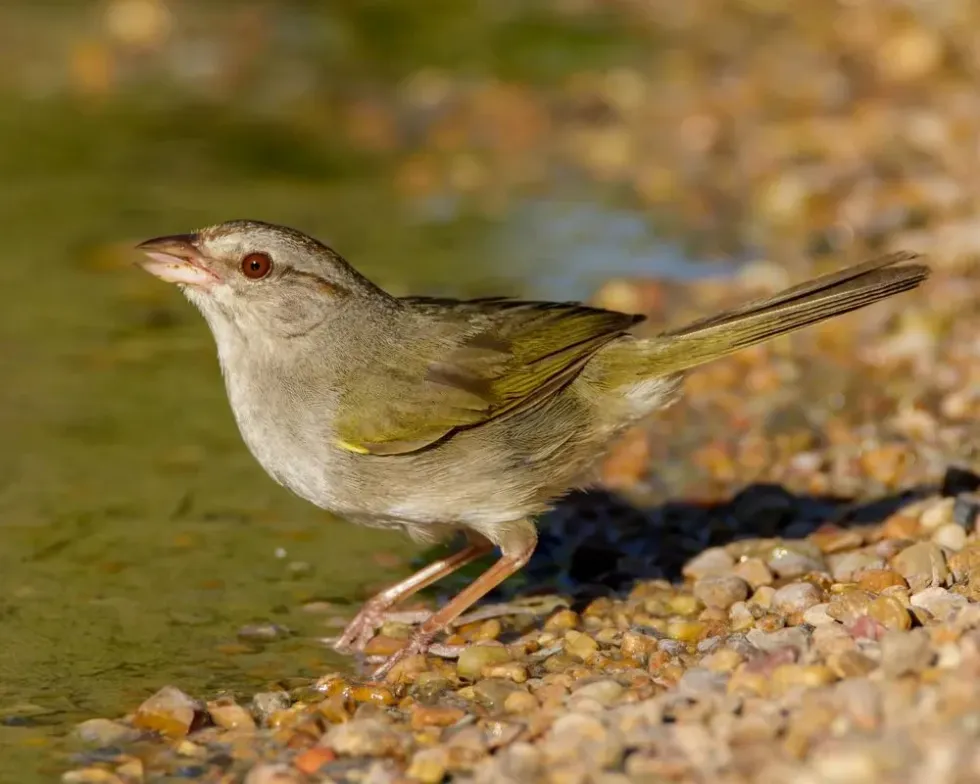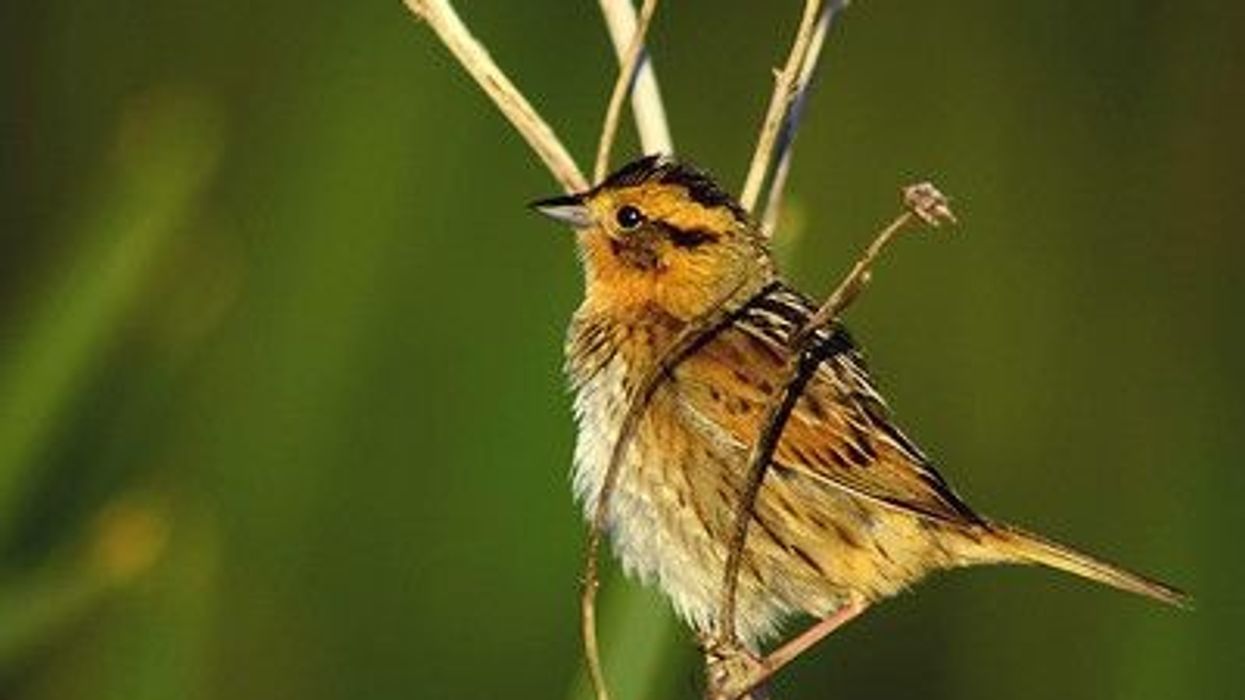Sparrows are divided into two sects, the Old World and New World species. In English, these sparrows are known as house sparrows.
Sparrows are known for their beautiful voices and their unique features as well. Sparrows are always associated with positive things and symbolize creativity, empowerment, or positivity. The olive sparrow has an olive back, and brown eye streak, and its olive back is its unique identifying feature.
This bird also has a brown stripe on the crown. The conservation status of this bird is Least Concern and they can sing a melodious song.
The olive sparrow (Arremonops rufivirgatus) is an intelligent being and controls insect populations all around the world. They can also feed on seeds.
This bird is native to southern Texas and other North American regions like Costa Rica and the Pacific lowlands of Mexico. They belong to the order Passeriformes, family Passerellidae and the class of Aves. Olive sparrows have a gray, olive unique coloration which helps distinguish them from other species.
In North America, more than 50 species of sparrows are seen. For more amazing facts and field guide about birds, check out similar species like with our chipping sparrow facts and swamp sparrow facts.
Olive Sparrow Interesting Facts
What type of animal is an olive sparrow?
Olive sparrow (Arremonops rufivirgatus) is a type of bird species endemic to southern Texas, North America, and other similar regions.
What class of animal does an olive sparrow belong to?
Olive sparrow (Arremonops rufivirgatus) is a type of bird that belongs to the class Aves, order Passeriformes, family Passerellidae and genus Arremonops.
How many olive sparrows are there in the world?
Olive sparrow's exact global bird population size is estimated at 2,100,000 individuals. Their current population size has been expected to face a decline.
Where does an olive sparrow live?
Olive sparrow, Arremonops rufivirgatus, live in the woods on trees. This species is endemic to southern Texas and seen in other regions of North America, including the Pacific lowlands of Mexico and Costa Rica.
What is an olive sparrow's habitat?
Olive sparrow (Arremonops rufivirgatus) lives in a habitat that has weedy fields, shrubby areas, and densely vegetated areas. They are omnivores and feed on both insects and seeds. They act as good seed dispersers in the environment.
They don't like coming close to urban and suburban regions. They build nests in tree holes, nest boxes, or crevices. They reside near dense, shrubby thickets and forest areas.
Who does olive sparrow live with?
Olive sparrow is largely a solitary bird and comes together near groups only during the breeding season. Sparrows are known to live in colonies, and it's likely for you to find more species in the same region if you have spotted one. The juveniles stay near other species of their own kind or their family.
How long does an olive sparrow live?
Olive sparrow's average lifespan is two to three years. The oldest recorded olive sparrow was eight years and three months old. This sparrow does not migrate and is found in shrubby thickets.
How do they reproduce?
Olive sparrow (Arremonops rufivirgatus) reproduces sexually. Breeding pairs are likely to form monogamous bonds for one mating season and may choose another mate for another season. Pairs stay together near each other. Little is known about their courtship behavior and rituals during the breeding season.
Olive sparrows are known to lay eggs frequently. Olive sparrows nest in tree holes and regions close to the ground. The female lays eggs in the nest post-mating. The clutch size is two to five eggs and may have from one to two broods.
What is their conservation status?
Olive sparrows belong to the order Passeriformes, family Passerellidae and are classified as Least Concern species by the International Union For Conservation Of Nature (IUCN). This species is endemic to southern Texas, Mexico, other North American and South American regions.
Olive Sparrow Fun Facts
What does olive sparrow look like?
The Texas sparrow is a unique sparrow with an olive-green back and has gray underparts. It is clever in behavior and quick to react.
Texas sparrow is small to medium-sized birds that feed on seeds as well as insects. It has a small face and light-colored beak with reddish black eyes.
Although they have an olive back, their underparts are light in color, and their feet are light-colored as well. They have a brown eye streak near their eye. This sparrow also has a brown stripe on the crown.
You can easily spot them near the ground or near thickets and shrubby areas. They are also seen in multiple North American regions and they lack the brown coloring common in other birds in the sparrow family.

How cute are they?
Olive sparrow (Arremonops rufivirgatus) birds are seen in Texas and in North America. This species can be easily spotted in north American regions. They are adorable birds, gray and olive in color with brown eye streak. The crown and their back is a unique identifying feature in this species. This bird is known for their sweet song and call.
How do they communicate?
The Texas sparrow is known as a good communicator. They communicate via song as well as calls within their range. They have courtship calls and make chirping sounds. Juveniles make a buzzy call to beg for food.
How big is an olive sparrow?
The olive sparrow is 5.3-5.9 in (13.5-15 cm) in length, which is two times bigger than the smallest sparrow in the world, LeConte's sparrow, which is 4.7 in (12 cm).
How fast can an olive sparrow fly?
Sparrows are known to fly at speeds of 28.58 mph (46 kph). They are mostly spotted on the ground but are also seen in trees.
The exact speed of the olive sparrows is not known as yet. The fastest bird in the world is the peregrine falcon that can fly at the speed of 242 mph (389 kph), which is almost eight times the speed of sparrows.
How much does an olive sparrow weigh?
The olive sparrow weighs 0.5-1.1 oz. (15-30 g). Olive sparrows feed on seeds and insects as well. Harris's sparrow is the largest of the sparrow species and weighs 0.92-1.73 oz. (26-49g).
What are the male and female names of the species?
Male and female species are not addressed differently. Male sparrows usually have an olive back, that is, olive green colored as compared to female species. Both sexes lack brown coloring.
What would you call a baby olive sparrow?
Baby olive sparrow is referred to as a fry or a nestling. Juveniles reside in a nest and are born naked at birth. They develop feathers and an olive back as they grow.
What do they eat?
Olive sparrows are omnivores and feed on seeds as well as insects. They prefer insects over seeds. They scratch their feet amid the dry leaf litter as they forage.
Seeds like sunflower seeds and others. They prefer thickets and brushes of the forest. Juveniles depend on their parents for food and communicate a buzzy call to beg for food from their parents.
Are they dangerous?
No, these birds are not dangerous to humans. The males are capable of fighting to the death. This is done between two bird species to showcase their territorial range as well as to showcase their dominance. Sparrow is afraid of their predators, which include hawks, eagles, owls, and snakes.
Would they make a good pet?
One can keep certain sparrow birds as pets but not all types of sparrows. Olive sparrow birds are rarely seen being kept as pets; however, such birds thrive best in their natural habitat range.
Did you know...
Grasshopper sparrow nest on the ground as compared to other sparrow birds who might build nests in tree holes or crevices of a similar kind. These birds of sparrow build nests amidst leaf litter.
Leaf litter constitutes of leaves, twigs, and pieces of bark. Other species of birds, too, are known to build nests on the ground. However, they protect their young at all times from possible predators.
Sparrows are attracted to light at night. These birds are also seen chasing moths in the night. Adult birds feed juveniles a large portion of proteins that they consume from insects.
Cats are major predators of juvenile sparrows birds and are known to kill large numbers of such small birds in their juvenile state.
The green-backed sparrow from the Yucatan Peninsula has a uniquely different voice for which it is identified.
If you find a bird egg on the ground untouched, it's best not to touch it and leave it. Since in most instances, parent birds are known to abandon their young.
This is more a disturbance response compared to them not liking others touching their eggs. In most instances, birds return to their nests in the ground or in trees, depending on the scent.
What bird looks like a sparrow but has a blackhead?
Olive sparrow looks similar to the dark-eyed junco, who has a black head and is similar in size. The dark-eyed junco is a similar species but belongs to a different family. The dark-eyed junco range is also in North America, similar to the olive sparrow. Their song and call are different.
Sparrows are more effective communicators and have a melodious song. Dark-eyed Junco is migratory and nest on the ground as well as on tree branches different from olive sparrows. Both birds are different in coloration as well.
What is special about sparrows?
There are 35 different types of sparrows in North America itself, and each one has their own unique feature. For example, the olive sparrow has an olive back. Some sparrows build nests on the ground; other build nests in tree crevices. Sparrows have smooth round heads and rounded wings.
Most female sparrows are brown in color. Males, too, have certain brown parts, but species like the olive sparrow lack the brown color. Have you ever come across any species of sparrows? Which type of sparrow did you come across?
Here at Kidadl, we have carefully created lots of interesting family-friendly animal facts for everyone to discover! For more relatable content, check out these tawny owl facts or pheasant facts pages.
You can even occupy yourself at home by coloring in one of our free printable olive sparrow coloring pages.










